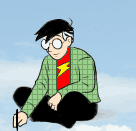Google Map Comics?
October 12th, 2009
Reader Sylvain Poitras emailed recently to suggest that the new ways people are using Google Maps to create online portfolios and game maps could also be applied to expanded canvas comics. It’s a cool idea. Anyone want to give it a try?
(And no, I have no idea why the last three blog post titles all ended in question marks.)
Posted in Experimental Comics, Technology















Hm, that’s an interesting approach. I’d be interested in giving it a shot on tor.com if I found a writer/artist willing to do it….
that seems like the perfect tool for the task of comics online, 🙂
Scott-
This post on the defunct hypercomics.net talks about a Googlemaps webcomic: http://hypercomics.wordpress.com/2008/07/19/and-penguins-got-steve-covered/
It also points to a fantastic archive from Penguin Books, where 6 authors put new twists on old stories, using some unique form of the web. Nestled in there is the Googlemaps story as well as stories told across fake blogs and twitter feeds, and even a VERY difficult to pull off, “choose your adventure” style story. Well worth a dive if you’ve not seen it already! The site is: http://wetellstories.co.uk/
–Neal
When developing my panal streamer I thought about the direct google maps approach.
But I actualy think for comics (easy of editing,links,dynamic elements…and general future possibilities) that irregular sized panels are better. Especially when you want multiple layers….if a layer dosnt contain much (like just speach bubbles), having a whole layer of squares dosnt make much sense.
Fine tuneing a comic that dosnt require constant re-dividing is much easier.
Of course though, regular squares is much easier to stream with predictable smoothness, so theres pros and cons.
The current state of my panal streaming format is here btw;
http://www.lostagain.nl/Panelstreamer%20Demo/panelstreamer.html#File=./psf/Layers.psc&X=438&Y=490
(url saves the open comic and position)
It mostly uses GWT (googles technology) but for irregular panels, and multiply layers.
The end goal of mine is try to get the psc format established so anyone can make infinite canvas comics without any coding knowledge.
Unfortuntely, I’m waiting for help from google on how they make it work on firefox (which by default lets you drag images outside frames). Works great on opera though.
[…] Comics no Google Maps É uma ideia. Scott McCloud. […]
Hi Scott – we completed some storytelling work in Google Earth last year which was an amazing unit of work.
http://tbarrett.edublogs.org/2008/12/01/google-earth-is-our-paper-part-5-a-week-in-review/
Giving the children a location as a stimulus was very exciting – I think this fits in with this idea.
Not exactly infinite canvas, but I did a series in June 2008, based on Google Maps screen caps, called “The World is an Abstract Comic.” See here:
http://blotcomics.blogspot.com/2008_06_01_archive.html
See also:
http://blotcomics.blogspot.com/2009/06/la-suburban-abstract-strip.html
I thinked this is cool to create a comic too:
http://prezi.com/j9anrjn-gdwj/view/#82
This is my “someday” plan, lol.
Prezi’s nice…flash lets you do rotation and get the smoothness.
But its not a format..we need a standard format so that various bits of software can read the same “comic maps”
As well as various creators and exporters being made for other software.
[/old rant]
[…] us all know how it works for you. I usually use Open Office for such projects.) Or maybe we can use Google Maps […]